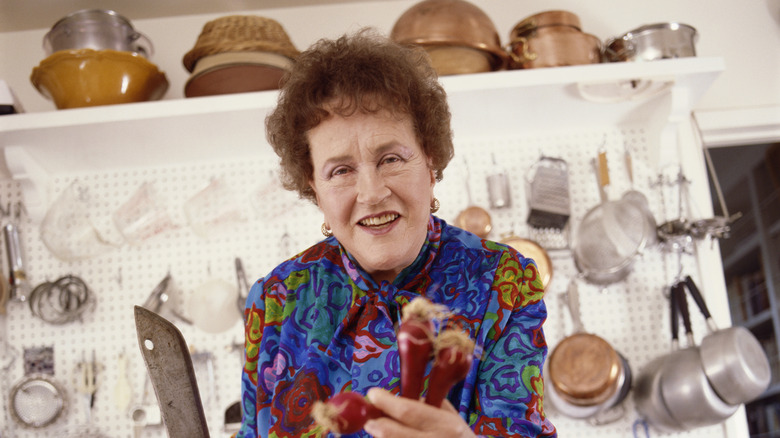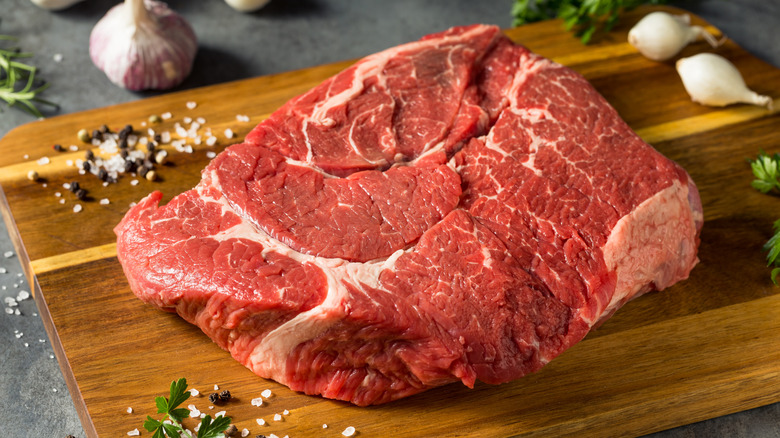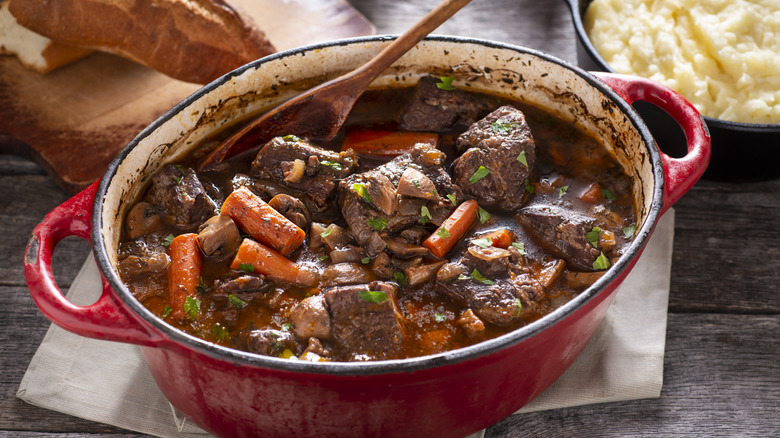The French Stew Julia Child Called The Best In The World
When it comes to ambassadors of French cookery, a few names spring to mind: Paul Bocuse, the brothers Michel and Albert Roux, and Joël Robuchon. But one familiar face might just eclipse them all when it comes to bringing brilliant French food to the masses. Julia Child wasn't French. But she loved their food enough to dedicate her life to promoting it, and in the process brought the joy of French cookery from Le Cordon Bleu (where she trained), to the rest of the world — and that meant making even the most complex flavors accessible. When it comes to complexity, few dishes can match the depth and warmth of a boeuf bourguignon.
Child called this humble French country stew "certainly one of the most delicious beef dishes concocted by man" in her book "Mastering the Art of French Cooking" — and she might well be right. It's a fantastically rich concoction, a biblical melding of meat, wine, aromatics, and time that create one of the truly great, all time dishes. Traditionally, bourguignon is made of beef, seared off (the Maillard reaction doing its good work), then stewed in red wine and beef stock with carrots, onions, garlic, and herbs, before being finished with baby onions, mushrooms, and bacon. Child's own recipe incorporates the bacon from the off, imbuing the whole dish with a rich porky undertone. The result is a truly addictive, warming, surprisingly fragrant, and rich stew, with a silky mouthfeel and soul-warming depth of flavor. It's a masterpiece.
What to consider when making beef bourguignon at home
There are two crucial elements to a good boeuf bourguignon: the right meat and the right wine. The dish has its origins (like many now iconic French dishes such as chicken chasseur) in so-called "peasant food." This is less of a literal description, and more an indicator of the spirit in which the food is cooked: unfussy, unpretentious, and sometimes time consuming but always accessible and delicious. Luckily, that means that finding the right ingredients for a great boeuf bourguignon can be both easy and affordable. When it comes to meat, a fatty, gelatinous cut will result in a much richer sauce, and a softer bite. Julia Child's recipe calls for chuck roast, which is a fantastic and easy to come by cut of meat that'll render beautifully, and tenderize throughout the cooking process resulting in a perfect, pull apart tender bite. If you can't find chuck roast, top round is another great, inexpensive cut for stunningly tender braised beef. Even brisket works well here.
As far as wine is concerned Burgundy is the traditional choice here — the dish is called "bourguignon", referencing Bourgogne (or Burgundy, when anglicized), the region it hails from. Really, though, any hearty red wine will do the job here. The deeper and richer the wine is, the deeper and richer your stew will eventually be, so go for a bold, full-bodied red like a merlot, malbec, or even a rich Italian grape like Nebbiolo for the most flavorful results.
Some optional upgrades to take your boeuf bourguignon to the next level
This is a deceptively simple recipe that thrives on its ability to turn just a few easy ingredients into something truly complex and delicious — but that doesn't mean the experimental cooks among us can't try to spruce it up a little. For instance: Your next boeuf bourguignon might benefit (like most things in life) from the addition of more booze! When it comes to braising meat, Julia Child isn't the only TV-famous chef who's got the goods. The Barefoot Contessa herself, Ina Garten knows a thing or two (her red wine braised short ribs are an instant classic, and her favorite recipe she's ever written.) When braising beef, she likes to add a splash of cognac to boost her stew. It rounds out the flavors involved, and brings a little welcome brightness to contrast. And in doing so, it really accentuates the rich, savory notes at play.
Another easy, but slightly less common upgrade is the addition of a pig's trotter. Yup, pig's feet can be a treat all on their own. They're a staple in classical French cooking, but they're particularly useful when braising. They're packed with natural gelatin, which will combine with the braising liquid and result in an even richer, silkier mouthfeel. Just add your pig's trotter with the rest of the ingredients once you've browned off your beef and you'll be well on your way to a truly luxurious French classic in no time.



